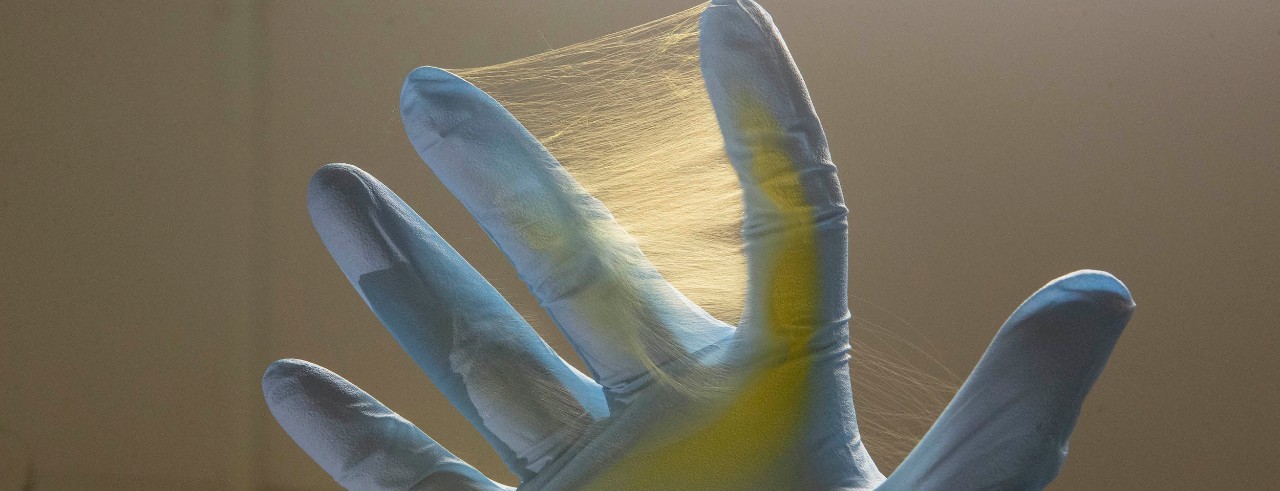
UC pioneers new brain cancer treatment
Using electrospun fibers, doctors and engineers can treat glioblastoma multiforme directly
A novel engineering process can deliver a safe and effective dose of medicine for brain tumors without exposing patients to toxic side effects from traditional chemotherapy.
University of Cincinnati professor Andrew Steckl, working with researchers from Johns Hopkins University, developed a new treatment for glioblastoma multiforme, or GBM, an aggressive form of brain cancer. Steckl’s Nanoelectronics Laboratory applied an industrial fabrication process called coaxial electrospinning to form drug-containing membranes.
The treatment is implanted directly into the part of the brain where the tumor is surgically removed.
The study was published in Nature Scientific Reports.
“Chemotherapy essentially is whole-body treatment. The treatment has to get through the blood-brain barrier, which means the whole-body dose you get must be much higher,” Steckl said. “This can be dangerous and have toxic side-effects.”

In UC's Nanoelectronics Lab, researchers use coaxial electrospinning to create fibers that contain a sheath of one material surrounding a core of another. Photo/Joseph Fuqua II/UC Creative Services
Steckl is an Ohio Eminent Scholar and professor of electrical engineering in UC’s College of Engineering and Applied Science.
Coaxial electrospinning combines two or more materials into a fine fiber composed of a core of one material surrounded by a sheath of another. This fabrication process allows researchers to take advantage of the unique properties of each material to deliver a potent dose of medicine immediately or over time.
“By selecting the base materials of the fiber and the thickness of the sheath, we can control the rate at which these drugs are released,” Steckl said.
The electrospun fibers can rapidly release one drug for short-term treatment such as pain relief or antibiotics while an additional drug or drugs such as chemotherapy is released over a longer period, he said.
“We can produce a very sophisticated drug-release profile,” Steckl said.

UC research associate Daewoo Han works in UC's Nanoelectronics Laboratory. He is lead author of a new study on glioblastoma. Photo/Joseph Fuqua II/UC Creative Services
The breakthrough is a continuation of work conducted by research partners and co-authors Dr. Henry Brem and Betty Tyler at Johns Hopkins University, who in 2003 developed a locally administered wafer treatment for brain tumors called Gliadel.
Unlike previous treatments, electrospun fibers provide a more uniform dose over time, said UC research associate Daewoo Han, the study’s lead author.
“For the current treatment, most drugs release within a week, but our discs presented the release for up to 150 days,” he said.
Glioblastoma multiforme is a common and extremely aggressive brain cancer and is responsible for more than half of all primary brain tumors, according to the American Cancer Society. Each year more than 240,000 people around the world die from brain cancer.
This represents a promising evolution for the current treatment of GBM.
Daewoo Han, UC research associate
The electrospun fiber created for the study provided a tablet-like disk that increased the amount of medicine that could be applied, lowered the initial burst release and enhanced the sustainability of the drug release over time, the study found.
Chemotherapy using electrospun fiber improved survival rates in three separate animal trials that examined safety, toxicity, membrane degradation and efficacy.
“This represents a promising evolution for the current treatment of GBM,” the study concluded.
While this study used a single drug, researchers noted that one advantage of electrospinning is the ability to dispense multiple drugs sequentially over a long-term release. The latest cancer treatments rely on a multiple-drug approach to prevent drug resistance and improve efficacy.
Steckl said the study holds promise for treatments of other types of cancer.
“Looking ahead, we are planning to investigate ‘cocktail’ therapy where multiple drugs for the combined treatment of difficult cancers are incorporated and released either simultaneously or sequentially from our fiber membranes,” Steckl said.
Featured image at top: UC applied coaxial electrospinning to create a new treatment for brain tumors. Photo/Joseph Fuqua II/UC Creative Services

UC engineering professor Andrew Steckl is developing new medical applications for coaxial electrospinning in his Nanoelectronics Laboratory. Photo/Joseph Fuqua II/UC Creative Services
Next Lives Here
The University of Cincinnati is classified as a Research 1 institution by the Carnegie Commission and is ranked in the National Science Foundation's Top-35 public research universities. UC's graduate students and faculty investigate problems and innovate solutions with real-world impact. Next Lives Here.
Become a Bearcat
- Apply online or get more information about undergraduate enrollment by calling 513-556-1100.
- Learn more about UC's many undergraduate and graduate programs.
Related Stories
UC celebrates record spring class of 2025
May 2, 2025
UC recognized a record spring class of 2025 at commencement at Fifth Third Arena.
‘Doing Good Together’ course gains recognition
May 1, 2025
New honors course, titled “Doing Good Together,” teaches students about philanthropy with a class project that distributes real funds to UC-affiliated nonprofits. Course sparked UC’s membership in national consortium, Philanthropy Lab.
DAAPworks reveals 2025 Innovation Awards – discover the winning...
May 1, 2025
Visionary projects stole the show during DAAPworks 2025, from wayfinding technology for backcountry skiers to easy-to-use CPR training kits for children.
